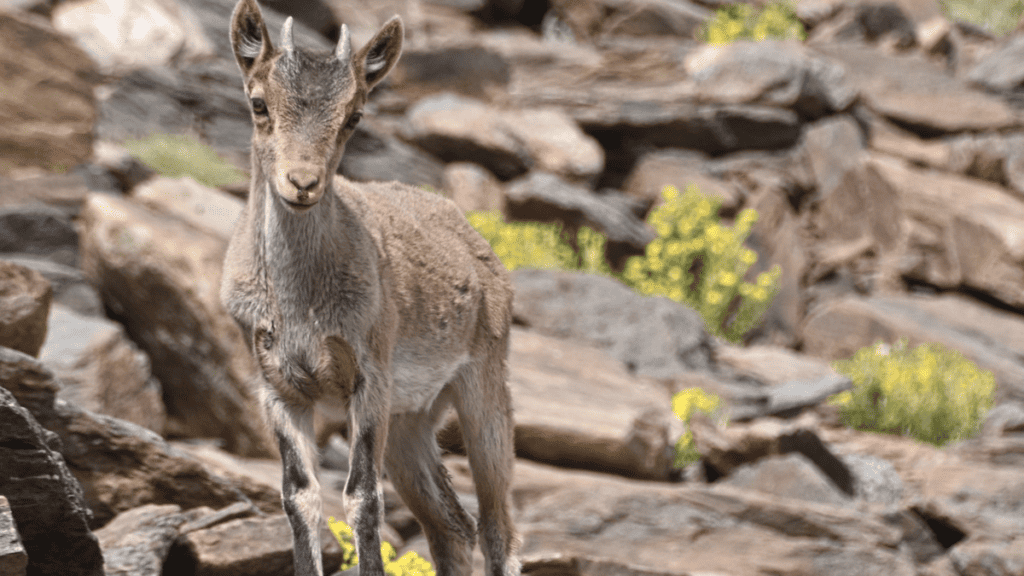
Over the years trail running has given me the unique opportunity to get close to various forms of wildlife in their natural environment. More than once the encounter was with something that could cause me serious injury or worse. Luckily there is sound trail etiquette for wildlife encounters that allows us to enjoy these encounters without causing the animals any undue stress.
When encountering animals in the wild it is important to remain calm and retreat slowly and quietly so that the animal can continue on its way without being startled or having undue stress. Remember, we are the intruder in their environment.
Let’s take a closer look at different wildlife encounters and how to deal with them. I’ll include my memorable encounters with 2 wild cats in Africa.
Trail Running and Wildlife Encounters: What to Do When You Meet Animals
While trail running in the mountains, I’ve had a number of wildlife encounters, often snakes like cobras. My 2 most memorable encounters involved large cats. The first of these was an early morning encounter with a Caracal. The other was an evening encounter with a Cape Mountain Leopard. With the Caracal I was running just before sunrise and it was on the trail as I rounded a corner. It started running along the trail away from me. I slowed my pace and let it get further away rather than trying to run the other way as prey would.
My encounter with the Cape Mountain Leopard was equally exciting. I was out running at sunset on a mountain farm. I was nearing the end of my run and was navigating the perimeter of a small lake that was about 300 yards from my friend’s house. On the lake shore was a large rock that I used the one side of to re-tie my shoelace. There it was, drinking water on the other side of the rock drinking water just a few feet away. My heart raced, but I remembered the importance of staying calm and knowing how to react. Slowly, I backed away, until I was safely able to rejoin the trail to my friend’s house. I felt honoured to have had that encounter as it is estimated that only between 500 and 900 Cape Mountain Leopards remaining in the wild.
This experience highlighted the crucial need for trail runners to be prepared for wildlife encounters. Knowing how to react can make all the difference in ensuring both your safety and the animal’s well-being. By staying calm, keeping a safe distance, and respecting the animal’s space, you can peacefully coexist with wildlife on the trails. Remembering to carry essential gear like bear spray and being knowledgeable about local wildlife behaviors can also help you feel more confident when faced with unexpected encounters.
Being able to react appropriately in wildlife encounters not only enhances your trail running experience but also contributes to the conservation of these magnificent creatures. Stay informed, stay respectful, and stay safe while enjoying the wonders of nature during your trail runs.
Understanding Wildlife Behavior on Trails
Understanding Wildlife Behavior on Trails is crucial for trail runners to navigate encounters safely. By recognizing common behaviors exhibited by wildlife, runners can proactively respond to potential situations.
Animals like deer may freeze in place when startled, while others, such as mountain lions, may exhibit predatory behaviors by stalking their prey. Understanding these behaviors allows runners to differentiate between harmless curiosity and potential threats. For example, knowing that a bear standing on its hind legs is likely trying to get a better view rather than preparing to attack can prevent unnecessary panic.
Moreover, recognizing signs of aggression, such as growling or raised fur, can prompt runners to slowly back away without triggering a defensive response. By staying calm and interpreting wildlife cues correctly, trail runners can mitigate risks and ensure a harmonious coexistence with animals in their natural habitat. This knowledge empowers runners to make informed decisions when encountering wildlife, promoting safety for both themselves and the animals they encounter.
Preparing for Encounters: Essential Gear and Knowledge
Trail runners must be equipped with essential gear and knowledge to navigate wildlife encounters safely. One crucial item to have is “bear spray,” a potent deterrent against aggressive wildlife like bears. Additionally, carrying “noise-makers” such as whistles or bells can help alert animals to your presence and avoid surprising them.
Knowledge of local wildlife is also key. Understanding the common species in the area and their behaviors can inform your responses during encounters. For example, knowing that certain animals are more active during dawn and dusk can help you plan your runs accordingly to minimize interactions.
Furthermore, it’s essential to have a basic understanding of how to react in different scenarios, such as when to stand your ground and when to slowly back away. This knowledge can prevent escalating situations and ensure both your safety and the well-being of the animals you encounter.
By being prepared with the right gear and knowledge, trail runners can approach wildlife encounters with confidence and respect, fostering a positive coexistence between humans and animals on the trails.
Keeping a Safe Distance: Best Practices for Wildlife Interaction
Trail runners can ensure a safe distance from wildlife by following key strategies. Firstly, it’s crucial to “stay alert” and be aware of your surroundings at all times. Keeping a lookout for signs of wildlife presence, such as tracks, scat, or rustling sounds, can help you anticipate encounters and adjust your route if needed.

Secondly, “avoiding direct eye contact” with animals is essential, as it can be perceived as a threat or challenge. Instead, maintain a calm demeanor and give wildlife space to move away peacefully.
Another effective practice is to “make noise” while running to alert animals of your presence. Clapping, talking loudly, or using noise-making devices like bells can help prevent surprising wildlife and reduce the likelihood of confrontations.
Lastly, “respecting wildlife’s personal space” is paramount. Keeping a safe distance means not approaching or feeding animals, as this can habituate them to human presence and lead to dangerous interactions in the future. By implementing these best practices, trail runners can enjoy their outdoor adventures while prioritizing the safety and well-being of the wildlife they encounter.
Identifying Common Trail Animals: Species Recognition Guide
When trail running, it’s essential to be able to identify common trail animals to ensure a safe and respectful encounter. One of the most iconic animals you may come across is the majestic “bear.” Bears are typically large, with shaggy fur and a distinctive hump on their shoulders. It’s crucial to remain calm and avoid sudden movements if you encounter a bear on the trail.
Another common predator to be aware of is the “mountain lion.” These elusive cats are known for their stealth and agility. If you spot a mountain lion, make yourself appear larger by raising your arms and making noise to deter them from approaching.
Snakes are also prevalent on trails, with species like rattlesnakes being a potential concern. Remember to give snakes their space and avoid provoking them.
Lastly, deer are a common sight on trails, known for their graceful movements and gentle demeanor. While they may seem harmless, it’s important to admire them from a distance and not attempt to approach or feed them.
By familiarizing yourself with these common trail animals and their characteristics, you can better appreciate the wildlife around you and ensure a harmonious coexistence on the trails.
Dealing with Predators: Tips for Predatory Wildlife Encounters
When facing encounters with predatory wildlife while trail running, it’s crucial to prioritize safety and act assertively to deter potential threats. One key tip is to maintain a confident posture and make yourself appear larger to intimidate predators like coyotes or mountain lions. By standing tall, raising your arms, and making loud noises, you can often discourage these animals from approaching.
Additionally, it’s essential to avoid behaviors that may trigger predatory instincts in wildlife. This includes refraining from running away, as it can stimulate a chase response in certain predators. Instead, back away slowly while maintaining eye contact to show you are aware of their presence and not a vulnerable target.
Carrying deterrents such as bear spray or noise-making devices can also provide an added layer of protection in case of aggressive wildlife encounters. Being prepared and staying alert are key elements in effectively dealing with predatory wildlife on the trails.
By following these practical tips and remaining assertive yet calm in the face of predatory wildlife, trail runners can navigate encounters safely and responsibly, ensuring a harmonious coexistence with these animals in their natural habitat.
Handling Unexpected Encounters: Uncommon Wildlife Situations
When facing less common wildlife encounters on trails, such as coyotes, moose, or porcupines, it’s crucial to remain calm and assess the situation carefully. In these uncommon situations, it’s important not to panic or make sudden movements that could startle the animals.
If you encounter a coyote, maintain eye contact and back away slowly without turning your back. Coyotes are typically wary of humans and will often retreat if given space. Avoid running or sudden movements that may trigger their predatory instincts.
When encountering a moose, give them plenty of space and avoid getting between a moose and its calves. If a moose displays signs of aggression, such as raised hackles or stomping, slowly back away while speaking calmly to show you are not a threat.
If you come across a porcupine, keep your distance and avoid any sudden movements that could startle them. Remember that porcupines have sharp quills that they can use for defense if they feel threatened.
By staying calm, assessing the situation, and respecting the space and behavior of these less common wildlife species, trail runners can navigate unexpected encounters safely and responsibly.
Trail Etiquette: Respecting Wildlife and Their Habitat
Trail etiquette plays a crucial role in minimizing human-wildlife conflicts and ensuring the safety of both trail runners and animals. By following simple guidelines, such as staying on designated trails and properly disposing of trash, trail runners can significantly reduce their impact on wildlife habitats. Respecting wildlife habitats means understanding that these areas are home to a variety of species and should be treated with care and consideration.
When on the trails, it’s essential to avoid venturing off designated paths to prevent disturbing nesting sites or disrupting natural habitats. Properly disposing of trash not only keeps the trails clean but also prevents wildlife from ingesting harmful materials. Additionally, refraining from feeding wildlife helps maintain their natural foraging behaviors and prevents dependency on human food sources.
By practicing trail etiquette, trail runners can coexist harmoniously with wildlife, preserving the natural beauty of the environment and ensuring the safety and well-being of all species involved. Remember, respecting wildlife and their habitats is not only a responsibility but also a way to show appreciation for the natural world around us.
When Wildlife Becomes Aggressive: Defensive Actions and Responses
When encountering aggressive wildlife while trail running, it’s crucial to remain calm and respond appropriately to ensure safety for both yourself and the animal. If faced with an aggressive animal, such as a bear or mountain lion, it’s important to avoid sudden movements and maintain eye contact without staring directly at the animal. Slowly back away while speaking calmly to show you are not a threat.
In the event of an attack, use defensive actions like making yourself appear larger by raising your arms or a jacket above your head. If the animal continues to approach, make loud noises, throw objects, or use bear spray as a last resort to deter the attack. It’s essential to never run from predatory wildlife as it may trigger a chase response.
Remember, the goal is to de-escalate the situation without causing harm to the animal. By understanding defensive techniques and responses, trail runners can effectively handle aggressive wildlife encounters and minimize the risk of harm to themselves and the animals they encounter.
Reporting Encounters: Contributing to Conservation Efforts
When it comes to encountering wildlife while trail running, reporting these experiences can play a crucial role in contributing to conservation efforts. By promptly sharing details of wildlife encounters with relevant authorities or conservation organizations, trail runners can actively participate in citizen science initiatives that aid in wildlife conservation.
Reporting encounters not only helps researchers and conservationists gather valuable data on wildlife behavior and distribution but also contributes to a better understanding of the interactions between humans and animals in natural habitats. This information is essential for implementing effective conservation strategies and ensuring the protection of wildlife populations and their habitats.
By encouraging readers to report their wildlife encounters, we empower them to become valuable contributors to the conservation of the natural world. Through citizen science, individuals can make a meaningful impact by sharing their observations and helping to shape conservation policies and practices. Together, we can work towards creating a safer and more harmonious environment for both wildlife and outdoor enthusiasts.
Educating Others: Spreading Awareness About Wildlife Safety
Educating others about wildlife safety is crucial for fostering a culture of responsible outdoor recreation. By sharing knowledge and tips on how to interact with wildlife respectfully, trail runners can help protect both animals and themselves. One effective way to educate fellow outdoor enthusiasts is by organizing workshops or seminars focused on wildlife safety and conservation. These events can cover topics such as understanding wildlife behavior, best practices for encounters, and the importance of maintaining a safe distance.
Additionally, leveraging social media platforms and online forums can help reach a wider audience and spread awareness about wildlife safety. Posting informative articles, infographics, and videos can engage and educate individuals who may not have access to traditional educational resources. Encouraging responsible behavior, such as staying on designated trails and properly disposing of waste, can also be emphasized in educational campaigns.
By actively engaging in educational initiatives and promoting responsible behavior, trail runners can play a significant role in preserving natural habitats and minimizing negative impacts on wildlife populations. Together, we can create a community that values wildlife safety and conservation, ensuring that future generations can continue to enjoy the beauty of the outdoors.
Reflecting on Encounters: Learning from Wildlife Experiences
Reflecting on wildlife encounters while trail running can be a valuable learning opportunity. Each encounter offers a chance to gain insights and lessons that can enhance our understanding of wildlife behavior and improve our interactions with animals. By reflecting on these experiences, trail runners can develop a deeper appreciation for the natural world and become more adept at navigating encounters in the future.
Consider the emotions, thoughts, and actions that arose during your encounters with wildlife. Did you feel fear, curiosity, or awe? How did you respond to the presence of animals on the trail? Reflecting on these aspects can help you understand your own reactions and behaviors in such situations.
Moreover, take note of any lessons learned from these encounters. Did you discover new information about a specific species? Did you realize the importance of maintaining a safe distance or respecting wildlife habitats? Reflecting on these lessons can help you adapt your approach to future encounters and contribute to a safer and more harmonious coexistence with wildlife.
By reflecting on your wildlife experiences while trail running, you can continue to grow as a responsible outdoor enthusiast and advocate for wildlife safety and conservation.
